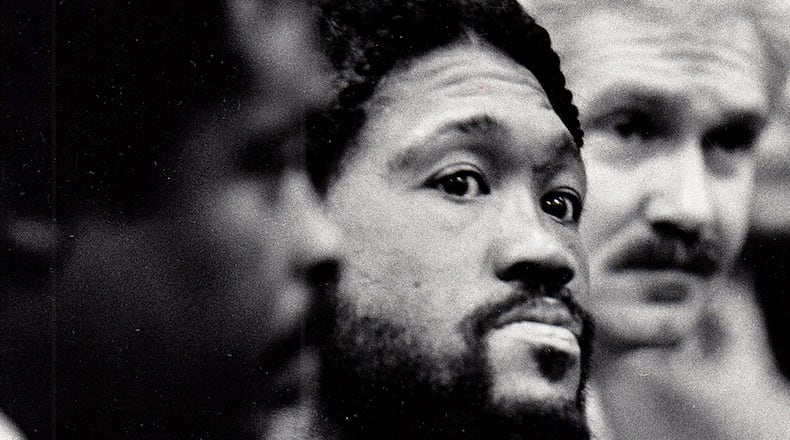Here are some key details of the case as it has progressed over the years.
• PHOTOS: Samuel Moreland, Southwest Ohio’s longest-running resident on Death Row
The crime
On the evening of Nov. 1, 1985, Tia Talbott returned from the grocery store to find Glenna Green, 46; Lana Green, 23; Datrin Talbott, 7; Datwan Talbott, 6; and Voilana Green, 6, dead in the family home at 35 South Ardmore Ave. in Dayton.
Three other children — Glenna Talbott, 2; Dayron Talbott, 11; and Tia Green, 5 — were beaten and/or shot and left for dead. Missing from the house is Glenna Green’s boyfriend, Samuel Moreland.
Moreland was arrested by police when he returned to the house. He had a bloody $20 bill in his pocket and gun powder residue on his hands, but not enough to conclude that he had recently fired a gun.
A week after the crimes, a tree trimmer found the .22-caliber Marlin Glenfield rifle in the dirt on South Kumler Avenue. Crime lab tests showed the bullets in the victims came from that weapon and the butt plate and screw matched the impression left on the forehead of Datwan Talbott.
Moreland’s account
Moreland claimed that he was too drunk to remember anything after 10 p.m. His blood alcohol content registered 0.225 percent — well above the 0.08 BAC level for drunken driving.
In another account, he said he drank four bottles of wine that day, including one with Glenna Green, returned to the darkened house around 10:30 p.m. and encountered three men.
He said he struggled over a rifle held by one of the men and was hit on the head and tied up but managed to escape through a window and struggle with a second armed man before he fell to the ground. Once he escaped, he drank more wine with friends and returned home, where police arrested him.
The trial
Moreland waived his right to a jury trial and instead faced a three-judge panel.
DNA testing was not done at the time of trial. Instead, it was circumstantial evidence and testimony from Dayron that led to Moreland being found guilty.
Dayron told the court he awoke on a couch as Moreland was pointing a gun at his grandmother. Moreland shot Glenna Green and turned the gun on Dayron, hitting him in the jaw and hand and then beating him unconscious with the gun, according to his testimony.
In April 1986, after a seven-day trial, the three-judge panel found Moreland guilty of aggravated murder and attempted aggravated murder. He was sentenced to death.
Multiple appeals
From his prison cell, Moreland has mounted appeal after appeal. He claimed he never consented to waiving his right to a jury trial, that his defense attorneys brought him to court under the influence of a powerful sedative and that Dayron’s testimony conflicted with his initial statements.
Moreland lost at the Second District Court of Appeals, Ohio Supreme Court, federal Sixth Circuit Court of Appeals and U.S. Supreme Court.
In early 2004, a Montgomery County judge denied Samuel Moreland’s bid for a new trial. Moreland was sent back to Death Row.
The Ohio Innocence Project
The Ohio Innocence Project joined Moreland’s defense in 2012 to help him apply for post-conviction DNA testing under Ohio’s newly revised laws.
Following a request by the Innocence Project, a legal clinic at the University of Cincinnati Law School, the court granted permission to have DNA evidence in Moreland’s case retested.
The first round of DNA testing was ordered in 2013 on the bloodstained $20 bill found in Moreland’s pocket during his arrest.
On July 10, 2014, Moreland’s legal team won the right to have shell casings, sweatpants and other crime scene items re-tested for DNA.
In 2017, after sitting in a property room for three years and five months, the items approved for DNA testing in 2014 were sent for DNA testing. It is unknown why it took so long to start the second round of testing.
Test results came back in a way that was not helpful to Moreland. They were indicative of guilt, but it wasn’t conclusively indicative.
Reprieve of execution
Moreland remains on Ohio’s Death Row at Ross Correctional Institution in Ross County, near Chillicothe.
Execution schedules are determined by a number of factors, including whether an inmate has exhausted all of his appeals.
On Feb. 13, 2025, DeWine issued reprieves to three inmates, including Moreland.
DeWine issued these reprieves “due to ongoing problems involving the willingness of pharmaceutical suppliers to provide drugs to the Ohio Department of Rehabilitation and Correction (DRC), pursuant to DRC protocol, without endangering other Ohioans,” the state said.
Moreland, who was scheduled to be executed on July 30, 2025, has a new date of execution of July 19, 2028.
About the Author








